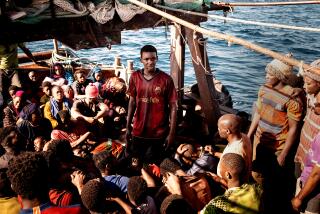Africa has produced exceptional players, but not a World Cup-quality team
- Share via
Standing on a circle of grass outside Benfica’s Stadium of Light in Lisbon is a larger-than-life statue of Eusebio, arguably the greatest soccer player ever to come from Africa.
The “Black Panther,” as he was known, was born in 1942 in what was then Lourenço Marques and is now Maputo, the capital of Mozambique.
But in a glittering 21-year career in which he was named Europe’s player of the year in 1965 and in which he was the top goal scorer at the 1966 World Cup in England, Eusebio da Silva Ferreira never once represented the land of his birth.
His club soccer was played for Benfica and his national team was Portugal. In those days, Mozambique was merely a colony, an offshoot of Portugal itself, and the idea that Eusebio could lead it to World Cup glory was laughable.
Times have changed.
In two months, South Africa will stage the first World Cup to be played on the African continent. It has been an 80-year wait, but Africa’s time has finally arrived.
On June 11, at the vast and calabash-shaped Soccer City Stadium in Johannesburg, the monthlong tournament will kick off after opening ceremonies that will feature Nelson Mandela, probably President Obama, Pele, and almost certainly Eusebio himself.
The “Black Panther” visited the city ahead of the FIFA Confederations Cup in 2009 and in an interview, said: “I was born in Africa and I am proud that a country in the region where I came from will be hosting the World Cup next year. It will definitely be one of the greatest ever.”
Among the 32 participating World Cup teams are six from Africa: Algeria, Cameroon, Ghana, the Ivory Coast, Nigeria and South Africa. Among the leading players on those teams are striker Didier Drogba of Ivory Coast’s Elephants, forward Samuel Eto’o of Cameroon’s Indomitable Lions, and midfielder Michael Essien of Ghana’s Black Stars.
Like Eusebio before them, all three ply their trade in Europe, along with hundreds of other African players who, in their migration north, have not only made their names — and in some cases their fortunes — but have enriched the European leagues in which they play.
But it has not really helped Africa. Not so far, anyway.
Africa might produce some of the world’s finest players, but the continent has yet to find its mark at the World Cup. No African team has ever progressed beyond the quarterfinals, a plateau first achieved by the Roger Milla-inspired Cameroon team at the Italia ’90 World Cup.
In that event 20 years ago, Cameroon startled the world on a sunny June evening in Milan when it defeated reigning world champion Argentina, with Diego Maradona in the lineup, 1-0, in the tournament’s opening game.
In fact, if there is one image that perfectly captures the launch of African soccer into a brighter future it is that of Cameroon’s Francois Omam-Biyik leaping high above a trio of shocked and open-mouthed Argentine defenders to head in the historic goal.
The joyous manner in which Cameroon played — it took England to the wire before losing, 3-2, in extra time in the quarterfinals — not only made the Indomitable Lions a fan favorite but opened the door for all African players.
Milla’s hip-wiggling celebratory dances with a corner flag whenever he scored a goal became one of the pictorial highlights of the tournament and won the hearts of fans worldwide who realized, belatedly, that African players could be entertaining as well as competitive.
In 2002, another team decked out in red, green and yellow matched Cameroon’s feat when the Lions of Senegal, inspired by El Hadji Diouf, upset world champion France in the tournament opener in Seoul and also advanced to the quarterfinals.
Beyond that, though, the pickings have been slim.
Egypt was the first African team to play in the World Cup, in Italy in 1934. The Pharaohs were bounced out in their only game, a 4-2 loss to Hungary in Naples.
Thirty-six years passed before another African team reached the World Cup, Morocco doing so in 1970 in Mexico after a boycott ahead of the 1966 tournament in England when FIFA refused to guarantee Africa a place in the World Cup.
Zaire was the continent’s lone representative in 1974 but went 0-3 and was outscored 14-0. That did not help Africa gain more representation and it would be many more years before its quota of World Cup berths was raised to its current level of five.
Tunisia represented Africa at the 1978 World Cup in Argentina and earned the continent its first victory, 3-1 over Mexico in Rosario.
All the while, Africa has continued to produce players of exceptional quality. Sadly, many of them have never reached the World Cup stage.
Ghana’s Abedi Ayew is a good example. A three-time winner of Africa’s player of the year award, he is better known as Abedi Pele, a reference to the Brazilian great. But during his time in the spotlight Ghana failed to qualify even once for the World Cup.
Another African great who never graced soccer’s biggest stage was the gloriously named George Tawlon Manneh Oppong Ousman Weah, better known simply as George Weah.
Weah starred for AC Milan and in 1995 became the first and so far only African player to be selected as FIFA’s world player of the year. But despite his individual prowess Weah was never able to qualify his country, Liberia, for international soccer’s showpiece tournament.
Clearly, Africa produces World Cup-level players. Its challenge now is to produce World Cup-level teams.
More to Read
Go beyond the scoreboard
Get the latest on L.A.'s teams in the daily Sports Report newsletter.
You may occasionally receive promotional content from the Los Angeles Times.








